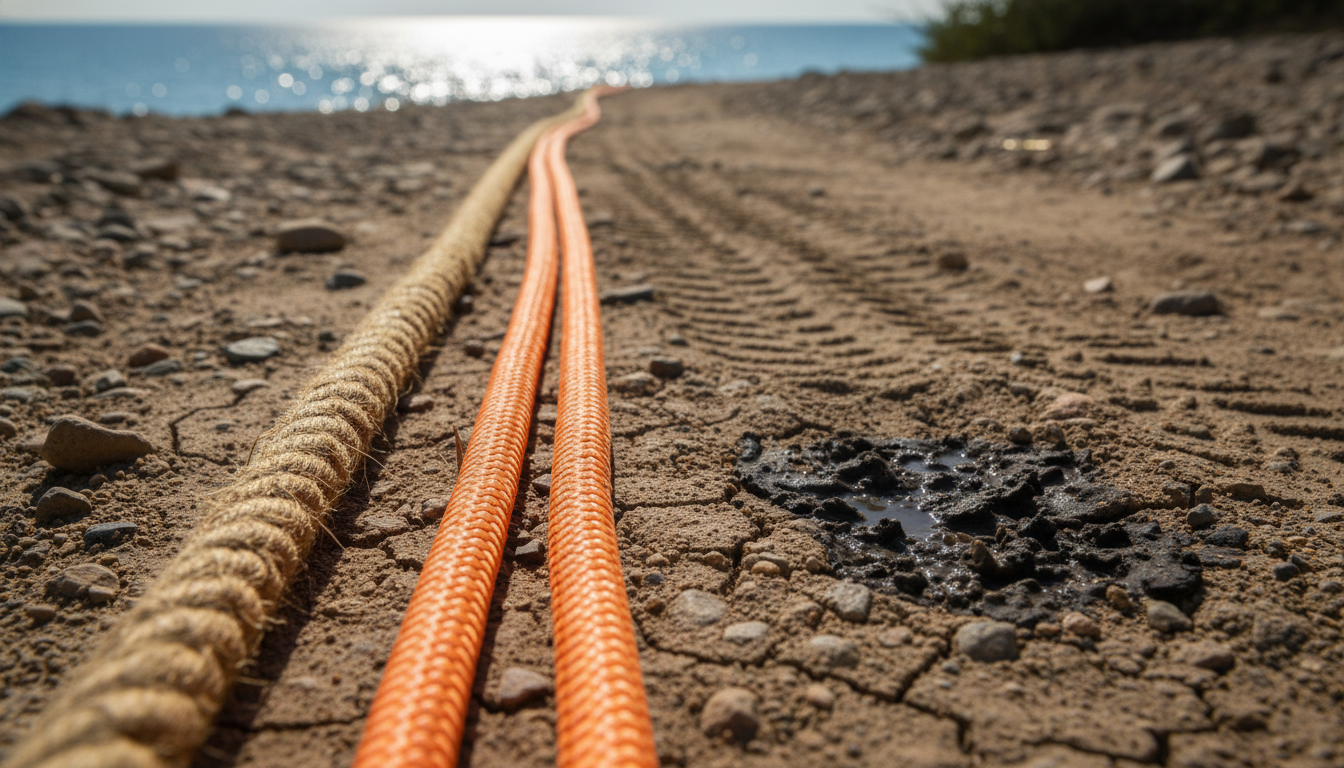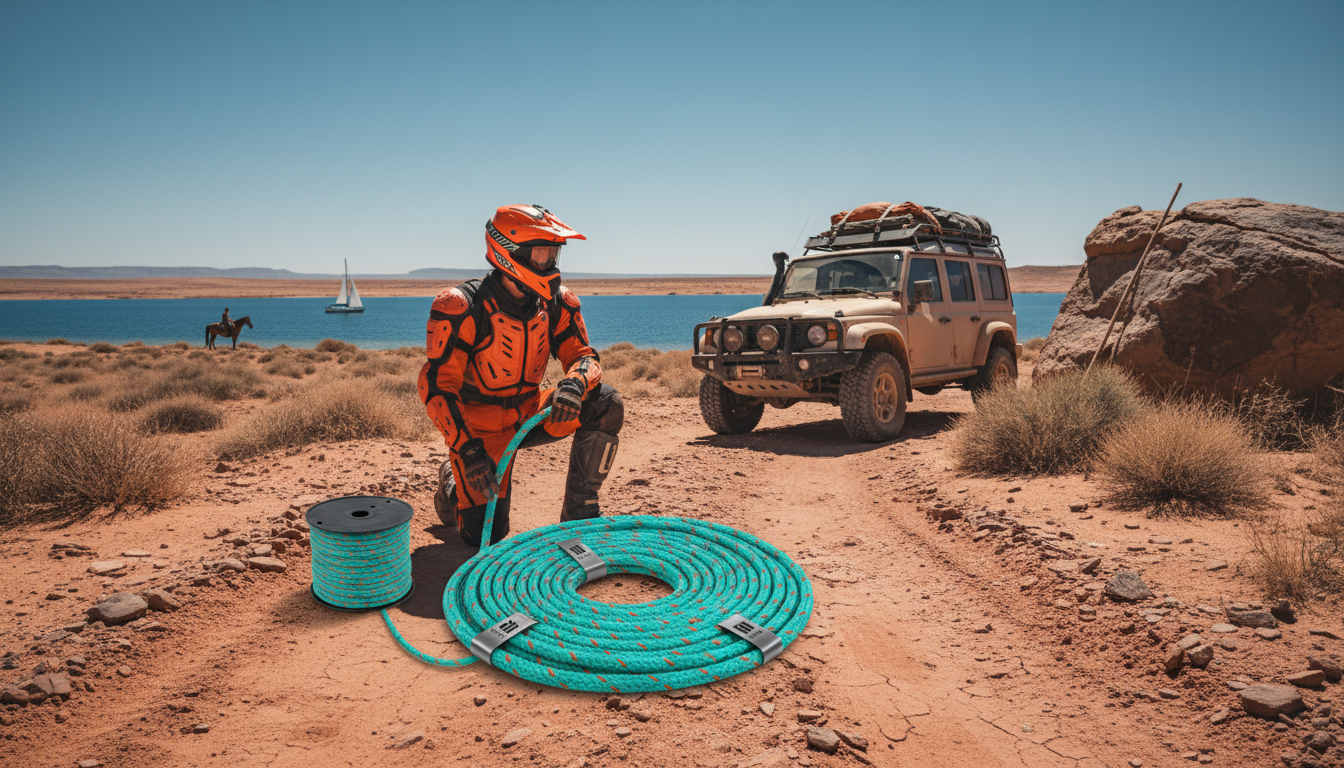Off‑road and marine jobs demand ropes engineered for strength, safety and durability—and iRopes’ custom‑specified lines are built to perform when conditions turn harsh.
Quick 2‑minute read: What you’ll gain
- ✓ Choose the exact diameter to meet your required working load without excess bulk.
- ✓ Cut UV‑induced degradation using our UV‑stabilised coatings and protective sheaths.
- ✓ Extend service life with abrasion‑resistant covers and wear indicators.
- ✓ Turn every coil into mobile branding with custom colours, tags and packaging.
Many crews assume any thick, generic rope will do. In practice, matching fibre and construction to the job makes recovery faster and safer. This guide explains ropes and more—covering the types of ropes and their uses in off‑road and marine work—so you can specify with confidence, and see how iRopes can build to your brief.
Exploring ropes and more: Overview of rope materials and applications
When you step onto a muddy track or lower a dinghy into the sea, the rope you trust can feel like an extension of your own hands. Historically, riders used horsehair rope for harnesses and pack‑slinging because it grips well and is biodegradable. Today, that spirit continues with modern nylon field ropes, which are widely used for off‑road recovery and many marine tasks. Let’s unpack how these materials differ and where each shines.
- Horsehair rope – valued for its firm grip and natural abrasion resistance, often seen in traditional pack‑sling applications.
- Jute and sisal – provide decent grip for low‑load tasks such as temporary tie‑downs on a campsite.
- Manila rope – favoured in traditional sailing rigs for its durability and classic look; note it absorbs water and can shrink.
Nylon field ropes became popular because they pair high tensile strength with useful stretch, which helps absorb shock during snatch recoveries or surge loads. Nylon tolerates salt water but absorbs moisture and has moderate UV resistance, so many lines use protective jackets or stabilisers for long sun exposure.
- High tensile strength – typically 7‑9 kN per mm², allowing slim diameters to handle heavy loads.
- Energy absorption – higher elongation than polyester, providing controlled stretch for shock loads.
- Durability – abrasion‑resistant with optional UV‑stabilised additives; note nylon sinks and can lose some strength when wet.
For quick reference, here are the six core rope types most users ask about, paired with a typical use case:
- Natural‑fiber rope – traditional pack‑sling and decorative marine rigging.
- Nylon rope – off‑road recovery and general‑purpose marine lines.
- Polyester rope – static mooring and load‑bearing winch applications.
- Polypropylene rope – lightweight flotation lines for water rescue.
- HMPE/Dyneema rope – ultra‑light, high‑strength mooring and tethering.
- Steel‑wire rope – heavy‑duty anchoring and winch cables.

Understanding these material differences helps you match the right rope to the right adventure, whether you’re hauling a rock‑cutter up a steep trail or anchoring a sailboat in a bustling marina. → Next, we’ll dive deeper into specific rope types and how their properties match off‑road and marine demands.
Understanding types of ropes and their uses for off‑road and marine environments
After spotting the six core rope families, the next step is to match the material to the job you’re tackling. Whether you’re pulling a 4×4 out of a sand trap or securing a dinghy at a bustling marina, the fibre you pick determines how the rope behaves under load, in water, and under the sun.

For off‑road recovery, three synthetic families dominate:
- HDPE (high‑density polyethylene) – floats, resists moisture, and delivers good strength at a light weight; its high‑modulus form HMPE (e.g., Dyneema) is widely used for synthetic winch lines thanks to exceptional strength‑to‑weight.
- Polyester – holds its shape under load, shows excellent UV stability and minimal stretch, making it reliable for winch‑assisted pulls that need predictable tension.
- Nylon – offers high tensile strength and greater stretch than polyester, which can be an advantage when you need shock absorption during sudden recovery bursts.
When you move from the desert to the dock, the priorities shift. Marine ropes must stay visible where needed, shrug off salty spray, and survive relentless UV exposure.
“In marine work, line selection depends on the job. Floating lines such as PP or HMPE improve visibility for tenders and rescue, while sinking nylon or polyester suit dock lines and anchor rodes,” says the iRopes Engineering Lead.
Key marine attributes to watch are:
- Floatation – polypropylene and HDPE naturally float; HMPE can be engineered to float while offering ultra‑high strength.
- UV resistance – polyester and HMPE accept stabilisers that help colour and performance resist fading under relentless sun.
- Corrosion protection – synthetic fibres resist rust, but any metal fittings should be stainless or coated to avoid galvanic decay.
Learn how Dyneema performs in marine settings in our essential guide to Dyneema rigging.
One of the most common “People Also Ask” queries is: Which rope is strongest? The concise answer is that HMPE/Dyneema tops the chart in strength‑to‑weight ratio, delivering roughly eight times the strength of steel for the same mass. Steel‑wire rope still offers very high absolute tensile load and heat resistance, but it’s heavy, can corrode, and lacks the flexibility needed for many recovery and mooring scenarios. For more details on marine mooring applications, see our UHMWPE mooring rope guide.
Strongest Rope
HMPE (Dyneema) provides the highest specific strength, out‑performing steel‑wire in weight‑critical applications. Steel‑wire remains a go‑to when maximum absolute load and heat resistance are required, though it sacrifices flexibility and buoyancy.
With those material clues in hand, you can now pair the right rope to the exact challenge—whether you need a floating, UV‑hardened line for offshore anchoring or a high‑stretch nylon tow for a sudden desert pull. Explore our customizable diameter rope solutions for tailored OEM projects.
Identifying kinds of ropes and their uses: Custom solutions and OEM/ODM options
Now that you have a clear picture of how materials behave, the next step is tailoring a rope to your exact off‑road or marine challenge. When you think of ropes and more, the ability to dictate diameter, colour, branding and accessories turns a standard line into a strategic asset.

iRopes lets you choose every parameter that matters: the exact diameter for the load you expect, a colour that pops in low‑light conditions, and optional branding that turns each coil into mobile advertising. Accessories such as thimbles, loops or specialised terminations can be integrated during splicing, while dedicated IP protection guarantees your design stays exclusive.
Diameter & Colour
Specify a precise cross‑section and select UV‑stable pigments; the line stays strong and visible whether it’s dragged across sand or tied to a mast.
Branding & Extras
Print logos, QR codes or safety markings directly onto the sheath, and add metal thimbles or custom loops to match your equipment.
Design & Prototype
Our engineers translate your brief into CAD models, produce a short‑run prototype, and let you test fit before full‑scale production.
Test & Certify
Every batch is tested within our ISO 9001 quality system using tensile (ASTM D2256), UV‑exposure and salt‑spray methods, ensuring the final rope meets the promised specifications.
Our OEM/ODM workflow is deliberately transparent: you submit a brief, we draft a design, you approve the prototype, we run ASTM D2256 break‑load tests, and finally we ship the finished rolls in your chosen packaging. This end‑to‑end chain means the “kinds of ropes and their uses” you require are delivered exactly as engineered.
Case Study – Off‑Road Recovery: A 4×4 dealer needed a high‑visibility recovery rope that cushioned shock loads and carried the dealer’s orange logo. iRopes produced a 12 mm nylon double‑braid kinetic rope in 30 m coils with UV‑stable dye and stainless‑steel thimble loops. The dealer reported smoother, more controlled pulls and stronger brand recognition on the trail.
Case Study – Marine Mooring: A luxury‑yacht builder requested a 16 mm double‑braid HMPE line with a custom navy‑blue sheath and embedded QR code for maintenance logs. After prototype approval, the line passed accelerated salt‑spray and cyclic‑load testing and shipped in waterproof cartons. The lighter line reduced handling effort and increased available payload.
Lead times for custom rope orders depend on material and quantity; we confirm schedules once the design is approved.
Whether you are matching a specific load class, complying with marine regulations, or wanting a rope that carries your brand across rugged terrain, iRopes can turn the insights from the previous sections into a fully customised, OEM‑ready solution that fits your business.
From traditional horsehair rope to high‑tech nylon field rope, you’ve seen how material choice drives performance in off‑road recovery and marine rigging. The guide has covered ropes and more, exploring the types of ropes and their uses, and showing the kinds of ropes and their uses for each adventure. With iRopes’ OEM/ODM expertise you can turn any specification into a branded, IP‑protected product, whether it’s a floating polypropylene or HMPE line for a dock, or an abrasion‑resistant polyester or nylon rope for a desert pull.
Request Your Custom Rope Solution
If you’d like personalised advice on matching the perfect rope to your off‑road or marine project, simply fill in the form above – our specialists will help you design the ideal solution.